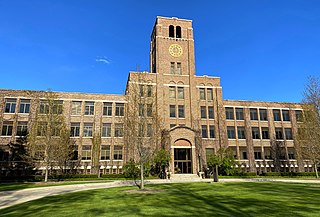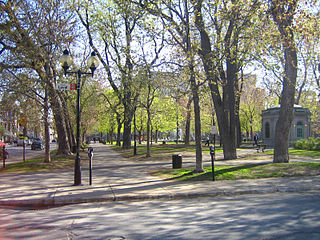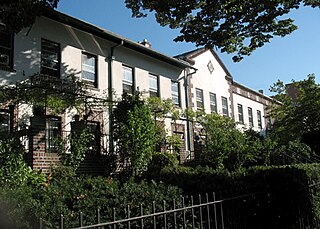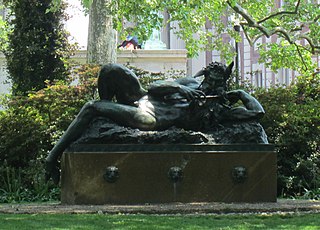
The J. L. Mott Iron Works was an American hardware dealer and manufacturer during the late 19th century. It operated in New York and was relocated to Trenton, New Jersey, where it ceased operations in the 1920s. [1]

The J. L. Mott Iron Works was an American hardware dealer and manufacturer during the late 19th century. It operated in New York and was relocated to Trenton, New Jersey, where it ceased operations in the 1920s. [1]
The J. L. Mott Iron Works was established by Jordan L. Mott in New York City in the area now called Mott Haven in 1828. [2] Mott was previously a grocer but he transitioned to iron works when he invented the first cast iron stoves that could burn anthracite coal. [1] The company would later expand to the manufacture and trading of "Stoves and ranges, hot-air furnaces, parlor grates and fenders, fire irons, cauldrons and kettles, statuary, candelabra, fountains garden seats, vases, iron pipes or every kind, water tanks, &c" are mentioned in Benson John Lossing, History of New York City. [3] Mott was interested in the patenting of inventions, but turned down President Buchanan's offer to make him Commissioner of Patents. [4]
The business was continued by Mott's son, J.L. Mott, Jr. The J. L. Mott Iron Works shop occupied the entire 11 floors of a building shop in Fifth Avenue and Seventeenth Street. [5] An account cited that the basement, first and second floors displayed plumbing and bathroom fixtures. [5] The rest of the upper floors were devoted to hospital, marine, and tile departments as well as the ornamental, heating, and furnaces departments. [5] Plumbing fixtures, including enameled cast iron bathtubs were also a J.L. Mott specialty.
At the Centennial Exposition in Philadelphia, 1876, an elaborate cast iron fountain, 25 feet tall, was exhibited by the company. According to the exposition review, Gems of the Centennial Exposition [6] all of the modeling of architectural forms, basins and figures was completed by artisans of the company. Figures were molded in clay, then cast in plaster to provide the moulds for the cast iron, in a process similar to bronze-founding. The lowest "pan" or basin was ten feet in diameter, said at the time to have been the largest such cast-iron basin in the United States. Some examples of the fountain figure The Boy with the Leaking Boot in various American and Canadian cities were purchased from the company.

The company relocated in about 1902 to Trenton, New Jersey. [7]

In 1917, artist Marcel Duchamp may have selected a urinal from the J.L. Mott showroom in Manhattan and presented it as a work of art called Fountain at the Society of Independent Artists exhibition. [8] This episode marks the introduction of the readymade in the history of modern art.
The Mott Iron Works company [9] was established in 1984 in Massachusetts, United States, and has no connection with the earlier company.

The Centennial International Exhibition of 1876, the first official World's Fair to be held in the United States, was held in Philadelphia, Pennsylvania, from May 10 to November 10, 1876, to celebrate the 100th anniversary of the signing of the Declaration of Independence in Philadelphia. Officially named the International Exhibition of Arts, Manufactures, and Products of the Soil and Mine, it was held in Fairmount Park along the Schuylkill River on fairgrounds designed by Herman J. Schwarzmann. Nearly 10 million visitors attended the exposition, and 37 countries participated in it.

A bathroom or washroom is a room, typically in a home or other residential building, that contains either a bathtub or a shower. The inclusion of a wash basin is common. In some parts of the world e.g. India, a toilet is typically included in the bathroom; in others, the toilet is typically given a dedicated room separate from the one allocated for personal hygiene activities. In North American English the word 'bathroom' is sometimes used to refer to any room in a residence that contains a toilet, regardless of the inclusion of a bath or shower.

Kohler Co., founded in 1873 by John Michael Kohler, is an American manufacturing company based in Kohler, Wisconsin. Kohler is best known for its plumbing products, but the company also manufactures furniture, cabinetry, tile, engines, and generators. Destination Kohler also owns various hospitality establishments in the United States and Scotland. In February 2017, Kohler Co. acquired UK-based Clarke Energy from the management team and ECI Partners, a multinational specialist in the engineering, construction, installation and maintenance of engine-based power plants and is an authorized distributor of GE's reciprocating engines in 19 countries worldwide.

A bathtub, also known simply as a bath or tub, is a container for holding water in which a person or animal may bathe. Most modern bathtubs are made of thermoformed acrylic, porcelain-enameled steel or cast iron, or fiberglass-reinforced polyester. A bathtub is placed in a bathroom, either as a stand-alone fixture or in conjunction with a shower.

Fountain is a readymade sculpture by Marcel Duchamp in 1917, consisting of a porcelain urinal signed "R. Mutt". In April 1917, an ordinary piece of plumbing chosen by Duchamp was submitted for an exhibition of the Society of Independent Artists, the inaugural exhibition by the Society to be staged at the Grand Central Palace in New York. When explaining the purpose of his readymade sculpture, Duchamp stated they are "everyday objects raised to the dignity of a work of art by the artist's act of choice." In Duchamp's presentation, the urinal's orientation was altered from its usual positioning. Fountain was not rejected by the committee, since Society rules stated that all works would be accepted from artists who paid the fee, but the work was never placed in the show area. Following that removal, Fountain was photographed at Alfred Stieglitz's studio, and the photo published in the Dada journal The Blind Man. The original has been lost.

The Jones and Laughlin Steel Corporation began as the American Iron Company, founded in 1852 by Bernard Lauth and Benjamin Franklin Jones, a few miles south of Pittsburgh along the Monongahela River. Lauth's interest was bought in 1854 by James Laughlin. The first firm to bear the name of Jones and Laughlin was organized in 1861, and headquartered at Third & Ross in downtown Pittsburgh.

Allen George Newman III was an American sculptor, best known for his statue "The Hiker".

Howell Works was a bog iron-based production facility for pig iron which was established in New Jersey in the early 19th century by American engineer and philanthropist James P. Allaire. It is notable as one of the earliest American examples of a company town.

J. W. Fiske & Company of New York City was the most prominent American manufacturer of decorative cast iron and cast zinc in the second half of the nineteenth century. In addition to their wide range of garden fountains, statues, urns, and cast-iron garden furniture, they provided many of the cast-zinc Civil War memorials of small towns throughout the northern states following the American Civil War. These were commonly painted to imitate bronze.

The Boy with the Leaking Boot is a statue showing a young boy, with a bare right foot, holding up his right boot and looking at it. The statue is about 4 feet (1.2 m) tall, and in many cases forms a fountain, with water emerging from the toe of the boot. There are at least 24, and reportedly "hundreds" of examples. The origins of the statue are obscure. The boy is reported to be a young Italian newspaper seller who drowned, or an American army drummer-boy who carried water in his leaking boot to help fallen comrades, or a young fire-fighter either using his boot in a bucket chain or emptying his boot after an incident, or possibly none of these. The statue has also been called The Boy with the Leaky Boot, Boy Immigrant and Unfortunate Boot.

The Fountains in Paris originally provided drinking water for city residents, and now are decorative features in the city's squares and parks. Paris has more than two hundred fountains, the oldest dating back to the 16th century. It also has more than one hundred Wallace drinking fountains. Most of the fountains are the property of the municipality.

The Bartholdi Fountain is a monumental public fountain, designed by Frédéric Auguste Bartholdi, who later created the Statue of Liberty. The fountain was originally made for the 1876 Centennial Exposition in Philadelphia, Pennsylvania, and is now located at the corner of Independence Avenue and First Street, SW, in the United States Botanic Garden, on the grounds of the United States Capitol, in Washington D.C.

Saint Louis Square is an urban square in Montreal's Plateau Mont Royal. Its eastern edge fronts onto Saint Denis Street, a major north–south artery. Square Saint Louis Street runs along both the square's northern and southern sides, while Laval Avenue runs along its western side.

Norwood Gardens is a small planned community in Astoria, Queens, bounded by 35th, 36th and 37th Streets between 31st Avenue and 30th Avenue. Norwood Gardens was planned and developed during a period of expansion in New York City.

Malleable Iron Range Company was a company that produced kitchen ranges made of malleable iron and other related products. The company existed from 1896 to 1985. Its primary trademark was Monarch and was often referred to as the Monarch Company.

The Great God Pan is a bronze sculpture by American sculptor George Grey Barnard. Since 1907, it has been a fixture of the Columbia University campus in Manhattan, New York City.

The Court Square Fountain, in the Court Square-Dexter Avenue Historic District of Montgomery, Alabama, was established in 1885 on top of an artesian well, which native Alabamians used long before the area was settled. The fountain contains statues based on Greek mythology. The surrounding area, once the location for Montgomery's bustling slave trade, has seen most of its historical buildings torn down; the fountain's statues were replaced with aluminum ones in the 1980s.

Adrian Janes was the owner of a significant American iron foundry in the Bronx, New York.

Pryke & Palmer Ltd. was a company of ironmongers and builders' merchants, in the City of London, England. Their illustrated and extensive catalogues have become sought-after by collectors, with some reproduced in facsimile editions.